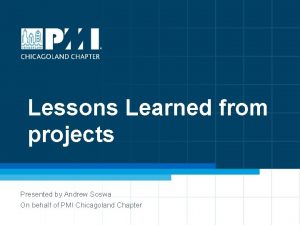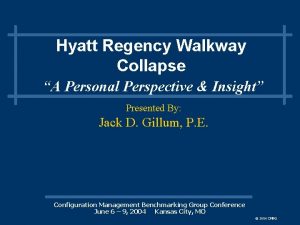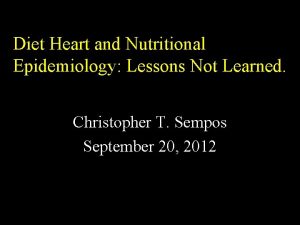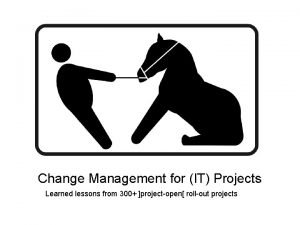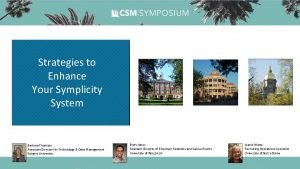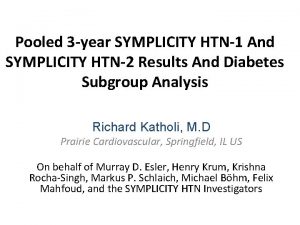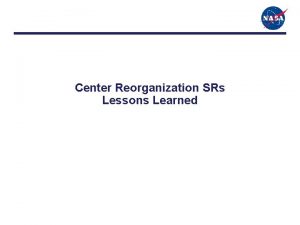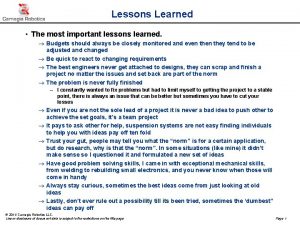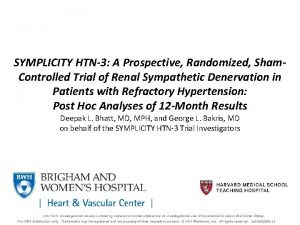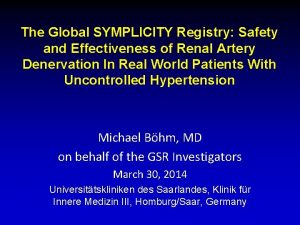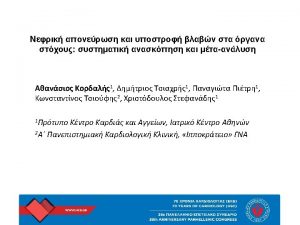Lessons Learned From the Results of the SYMPLICITY
























- Slides: 24

Lessons Learned From the Results of the SYMPLICITY HTN 3 Trial Industry View Sandeep Brar, M. D. Director, Clinical Research Medtronic, Santa Rosa, CA Sandeep. brar@medtronic. com

Symplicity HTN-3: severe drug-resistant HTN SBP >160 • • Randomized 2: 1, Sham Control, 535 subjects Randomized, 1441 Enrolled (63% Screen Failure Rate) Complex Screening Process including maximum tolerated doses of antihypertensive meds No check for medication compliance 8 touch points prior to pr EP 2 weeks 6 M Large SD in OSBP and ABPM 1 M 3 M Home BP & Pts on >5 meds Control Confirmatory Med Confirmation Screening Initial Screening • Office SBP ≥ 160 mm. Hg • Full tolerated doses of ≥ 3 meds • No HTN med changes in past 2 weeks • No plan to change meds for 6 M • Medical Hx Renal Angiogram 2 weeks Home BP & Med Confirmation • Office SBP ≥ 160 mm. Hg • Documented compliance on meds • Lab work Primary Endpoint • If eligible anatomy, randomize “on the table” • 24 hr ABPM SBP ≥ 135 30 days or maximum 6 weeks in exceptional circumstances 1 o Endpoint: Change in Office Systolic Blood Pressure 2 o Endpoint: MAE through 1 month, Stenosis to 6 m 2 | MDT Confidential and Proprietary; Do Not Copy or Distribute 2 weeks Treatment 1 M 3 M Home BP & Med Confirmation • Patient and Research staff performing 1, 3 & 6 month follow-ups are blinded to treatment status • No changes in medications for 6 M 6 M 1260 M

Primary Efficacy Endpoint Δ = -2. 39 (95% CI, -6. 89 to 2. 12) P=0. 26* Δ = -14. 1± 23. 9 Δ = -11. 7± 25. 9 P<0. 001 Office SBP (mm Hg) 200 150 180 mm Hg 168 mm Hg 166 mm Hg Baseline 6 Months 100 50 0 (N=364) (N=353) Denervation 3 | MDT Confidential and Proprietary; Do Not Copy or Distribute (N=171) Sham *P value for superiority with a 5 mm Hg margin; bars denote standard deviations

Powered Secondary Efficacy Endpoint Δ = -1. 96 (95% CI, -4. 97 to 1. 06) P=0. 98* 24 hour mean systolic ABPM (mm Hg) 180 150 Δ = -6. 8± 15. 1 Δ = -4. 8± 17. 3 P<0. 001 159 mm Hg 120 152 mm Hg 160 mm Hg 154 mm Hg Baseline 6 Months 90 60 30 0 (N=360) (N=329) Denervation 4 | MDT Confidential and Proprietary; Do Not Copy or Distribute (N=167) (N=162) Sham *P value for superiority with a 2 mm Hg margin; bars denote standard deviations

Multivariate predictors of systolic blood pressure change at 6 months Covariate RDN group (N=318) Estimate (mm Hg/attempt) P value Baseline Office SBP at ≥ 180 -14. 31089 <0. 0001 Total Number of Attempts -0. 93574 0. 040 Aldosterone Antagonist -9. 77411 0. 002 Vasodilator 7. 55107 0. 005 Baseline Office SBP at ≥ 180 -8. 00441 0. 064 African American race -11. 97485 0. 003 Alpha-1 blocker use -12. 00325 0. 044 Control group (N=169) All covariates are positive predictors for increasing SBP reduction except vasodilator use at baseline which is a negative predictor for SBP drop from baseline Univariate P <0. 2 required to enter the model Kandzari et al, Eur Heart J 2014

6 Learnings from HTN-3 • Procedure • Medication Adherence • Population

Impact of number of ablations on difference in 6 month office SBP change between denervation and propensity matched sham subjects 7 ≤ 9 15 =10 =11 =12 or 13 -5. 0 -4. 1 ≥ 14 12. 1 10 5 0 -0. 4 -5 -10 -15 P value for trend = 0. 01 -14. 1 -20 95% CI 12. 09 [-0. 33, 24. 51] P* 0. 056 RDN SBP -6. 38 ± 23. 04 (33) change (n) Sham SBP -18. 47 ± 27. 85 (35) change (n) -0. 42 [-12. 24, 11. 40] -4. 97 [-15. 32, 5. 38] 0. 943 0. 342 0. 465 0. 061 -14. 99 ± 24. 60 (33) -12. 58 ± 20. 97 (37) -9. 69 ± 16. 49 (35) -24. 27 ± 26. 84 (26) -14. 57 ± 23. 84 (34) -7. 61 ± 23. 62 (37) -5. 56 ± 29. 25 (36) -10. 22 ± 26. 49 (27) Kandzari et al. European Heart Journal: 2014 -4. 13 [-15. 38, 7. 12] -14. 05 [-28. 76, 0. 66] *P value change in SBP for RDN compared with sham

Procedural Variability 8 Goal: To achieve 4 -quadrant ablation pattern for optimal denervation Cross-section of artery Inferior Anterior Superior Lesion 4 quadrant ablation pattern Bhatt, TCT 2014 Posterior

HTN-3: Ablation Pattern Led to Considerable Variation in 6 M SBP Changes RDN Only Office ABPM Home 0 n=253 n=68 n=19 n=236 n=62 n=17 n=248 n=66 n=19 Change in Blood Pressure (mm Hg) -10 -20 -6. 3 -14. 2 -7. 7 -10. 3 -7. 3 -8. 2 -17. 2 -9. 0 -24. 3 -30 RDN + Crossover Office 0 ABPM n=314 n=83 n=27 n=289 n=76 n=24 n=308 n=82 n=27 -6. 4 -10 -20 Home -14. 6 -7. 50 -8. 2 -12. 1 -8. 2 -16. 7 0 Four-quadrant ablations -30 -27. 3 1 Four-quadrant ablation (Right or Left) Four quadrants = 1 superior, 1 inferior, and 2 posterior -10. 60

New View of Renal Nerve Distribution 10 Renal nerves have a positional bias on radial distance from the arterial lumen: distal nerves are closer Distal Proximal Prior concept – Uniform radial distribution Distal Proximal Current concept – Non-uniform radial distribution

Summary of Knowledge Gained 11 • Procedural variability impacts efficacy of denervation procedure • 4 -quadrant ablation pattern appears to correlate with more consistent reduction in blood pressure • Renal nerves are closest to the lumen at the distal portion of the renal artery • Pre-Clinical & Clinical data suggest that a combination of branch & main renal artery treatments will produce a larger and more consistent decrease in blood pressure

12 Learnings from HTN-3 • Procedure • Medication Adherence • Population

Medication Adherence Issues 13 • Medications were a potential confounder in HTN-3 – Protocol required patients be on maximum tolerated doses of at least 3 hypertension medications – Patients were on an average of 5 antihypertensive medications – Despite the protocol requirement, many patients changed medications during the study – Drug adherence not measured but believed a key uncontrolled variable

HTN 3: Medication Changes to 12 Months Baseline to 6 -Months Patients With Medication Changes (%) 60 50 40 44% 39% 60 53% 50 51% 39%* 40 30 30 20 20 10 10 0 0 RDN 6 Months to 12 Months Sham N = 139 RDN Crossover N = 72 Non-Crossover *p=0. 036 for difference from RDN group

Changes in Antihypertensive Medication Denervation group (n=364) Sham group (n=171) Baseline number of medications 5. 1 ± 1. 4 5. 2 ± 1. 4 6 month number of medications 5. 0 ± 1. 4 5. 2 ± 1. 6 Medication change SV 1 to SV 2 18 (4. 9%) 13 (7. 6%) Any medication change between baseline and 6 months 139 (38. 2%) 72(40. 3%) >1 change between baseline and 6 months 67 (18. 4%) 38 (22. 2%) Decreased number of medications or doses 52(14. 3%) 23 (12. 8%) Increased number of medications or doses 31 (8. 5%) 17 (9. 9%) Combination of increases and decreases in medication and/or dose 56 (15. 3%) 32 (18. 7%) Medication change related to an adverse event or symptom change 65 (17. 9%) 29 (17. 0%) Medication change related to SBP <115 mm Hg 75 (20. 6%) 45 (26. 3%) Medication change related to SBP increase >15 mm Hg 14 (3. 8%) 5 (2. 9%) Reasons for Medication Changes * Data are mean (SD) or n (%); SV = screening visit * More than 1 reason for a change could be documented

Summary of Knowledge Gained 16 • Medication adherence likely impacted the HTN-3 results • Complexity of medication regimen impacts adherence • Maximum tolerated dose of 3+ medications is not sustainable as a large % of patients required modifications to their medication

17 Learnings from HTN-3 • Procedure • Medication Adherence • Population

Change in SBP at 6 M Within Pre-specified Subgroups 18

A Large SBP Drop occurred in the African American Control Group Change in Office SBP at 6 Months (mm Hg) 0 Non-African American N=264 N=120 N=85 N=49 -5 -8. 6 -10 -15 -20 -15. 2 -15. 5 -6. 6 [-11. 8, -1. 4] P=0. 01 Baseline 179. 5 SBP, mm. Hg RDN Sham 178. 6 -17. 8 2. 3 [-7. 3, 11. 8] P=0. 64 180. 6 183. 9 Flack, TCT 2014

Systolic blood pressure change, mm Hg African American Control Subjects on Vasodilators had a Large BP Drop: Is Regimen Complexity and Change in Adherence a Confounding Factor? 0 Non-African American on Vasodilators Not on Vasodilators N=92 N=49 N=42 N=28 N=181 N=72 N=48 N=22 -5 -5. 9 -10 -15 -10. 3 -10. 4 -12. 3 -12. 7 Sham -4. 4 [-12. 9, 4. 1] p=0. 30 -17. 6 -20 -21. 9 -25 Baseline SBP, mm. Hg -18. 2 -7. 1 [-13. 7, -0. 6] p=0. 03 -5. 6 [-19. 2, 8. 1] p=0. 42 9. 6 [-4. 0, 23. 2] p=0. 16 -30 178. 9 180. 9 RDN 180. 6 187. 1 179. 8 177. 1 180. 6 179. 9

HTN 3 -Regional Variability: Systolic office and ambulatory blood pressure change at 6 months by Region Social-economic factors may have had an effect on the level of compliance Office -4. 5 -5. 3 -15. 8 -4. 4 Northeast -10. 0 -16. 6 Midwest Southeast 2. 2 -1. 3 Office -8. 4 -4. 5 ABPM -8. 3 West ABPM Office ABPM -5. 0 South -8. 1 -12. 7 -7. 6 -15. 6 -8. 4 ABPM -14. 2 -16. 1 RDN Control

True Population Difference With African Americans? 22 • Other factors beyond ethnicity may have played a role in the different outcomes in African Americans vs non-African Americans – Important to note the RDN groups responded similarly • Large sham response observed in the South and South East where there was a higher proportion of African Americans – However, Non-African Americans also saw a similar sham response in those regions implying regional treatment or behavior differences • Certain medications (complex daily regimens, vasodilators) were more often prescribed in African Americans creating the potential for increased adherence issues in specific subgroups

Summary of Knowledge Gained 23 • Perceived population differences (AA vs non-AA) likely related to factors other than race (i. e. patient behavior, specific drugs prescribed, complexity of drug regimen) • Future renal denervation studies should study a less severe resistant hypertension population

Many Learnings from HTN-3, But Questions Remain 24 • Is there a synergistic, neutral, or antagonistic relationship between RDN and antihypertensive drugs? • Will taking an “off-meds” approach lead to a greater drop in blood pressure? – Study populations ON and OFF medications? • What is the impact of branch treatment on blood pressure? – Assess the impact of branch treatment • Can we minimize the issue of drug adherence? – Enroll stable patients on less complex medication regimes that could lead to increased adherence
 Lessons learned repository
Lessons learned repository Pmbok lessons learned
Pmbok lessons learned Lessons we can learn from ants
Lessons we can learn from ants Workday implementation lessons learned
Workday implementation lessons learned Obadiah in the book of kings
Obadiah in the book of kings Strawman process
Strawman process Lessons learned suomeksi
Lessons learned suomeksi Lessons learned faa
Lessons learned faa Six sigma lessons learned
Six sigma lessons learned Life of pi moral lesson
Life of pi moral lesson Lessons learned from mount carmel contest
Lessons learned from mount carmel contest Is josiah luke a dwarf
Is josiah luke a dwarf Lesson learned in typhoon yolanda
Lesson learned in typhoon yolanda Hyatt regency walkway collapse lessons learned
Hyatt regency walkway collapse lessons learned Nerc lessons learned
Nerc lessons learned Tac lessons learned
Tac lessons learned Hydrotopia
Hydrotopia 2 chronicles 34:1-3
2 chronicles 34:1-3 Lessons learned ground rules
Lessons learned ground rules Lessons not learned in blood
Lessons not learned in blood Change management lessons learned
Change management lessons learned Dps project title
Dps project title Symplicity wvu law
Symplicity wvu law Symplicity rutgers law
Symplicity rutgers law Wm symplicity
Wm symplicity

